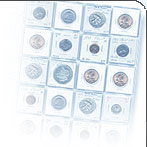Coin Glossary
You can find most popular coin collecting phrases in this coin glossary.

F
face value - the exchange value for which a coin is made to be spent or exchanged. Example: A US quarter's face value is 25 cents. Yet if it is silver or a rare date the collector value may be more. Face Value is Not its collector or precious metal value.
fair - A very heavily worn coin. Date may only be partially visible. One of the lowest grades of a coin, F-2. See Coin Grading
fantasy piece – this is any coin made for sale to collectors and includes most restrikes.
fiat money - currency or coin that looses it's value, retaining no substantial backing.
filler - a coin used to "fill in" the place in a collection until a better grade coin can be found or purchased to take its place. Often a low grade or damaged coin may be used as a filler until a nice one can be found.
field - the background surface of a coin not used for the design or inscription
fine - one day I told my wife she looked "fine". She got upset. To me I was saying she looked "nice". To her I was saying she looked "just OOkay". The same can be said about this coin grading term. Fine is a medium grade coin. It corresponds to F-12 and F-15 of the current grading standards. A Fine coin will have some detail present in the recessed areas. However, it is not sharp and there are some details still missing. You may be pleased to locate a fine grade coin, particularly when the coin is scarce or rare. However, a fine coin when common is not as great a treasure. See Coin Grading
fineness - the purity of a coin, medal, or precious metal item. Uses a scale of 0 to 1.000. Examples: A silver coin with fineness of .999 would be as pure as a coin can be. A silver coin with fineness of .500 would be made of 50% silver. Most 1964 and earlier US silver coins were .900 fine, or 90% pure silver.
flan - a planchet or coin blank. (Coin that has not yet been stamped with a design.
Franklin Half dollar - Franklin Half dollars are sometimes called Liberty Bell halves because of the Liberty bell design on the reverse. The United States government made the Benjamin Franklin Half dollar from 1948 to 1963. Large numbers of them were melted during the big silver meltdowns of the late 1900's.
friction - A frontiersman might rub two sticks together and the result is a fire. The rubbing of a coin can result in a wear on its surface. Typically, friction causes various degrees of noticeable wear and results in lowering the desire (and value) of a coin. Friction can be caused by a coin sliding in a holder, coin drawer, or even by a good intending collector who tries to "clean" the coin.
frosted proof - a proof coin that has a mirror like surface in the background with a frosted (or dull) surface on the design. Proofs prior to 1937 and again beginning in the 1970's have frosted designs. Sometimes occurs in other years although not as often. Some frosted proof coins will bring a premium price.





